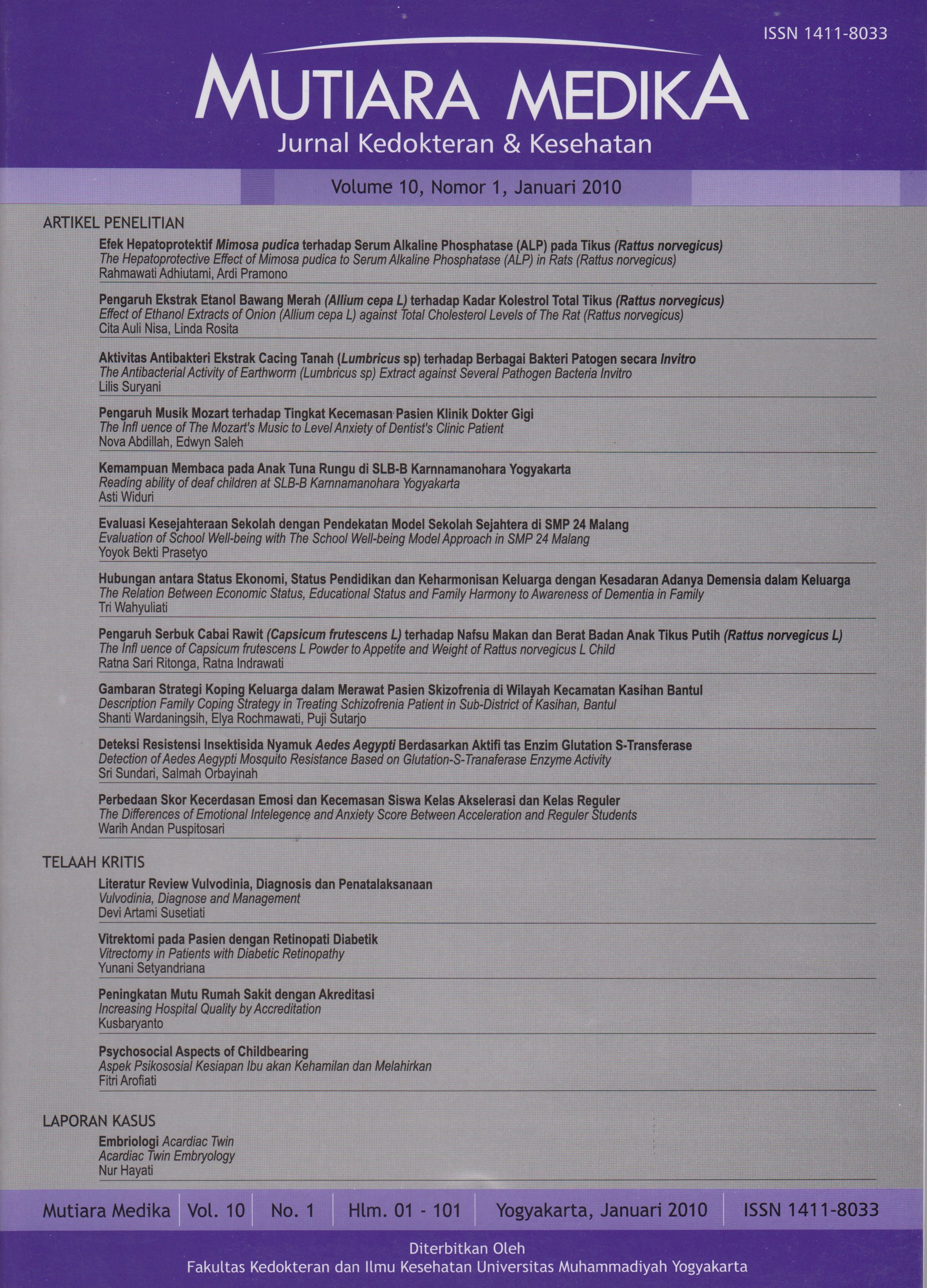Kemampuan Membaca pada Anak Tuna Rungu di SLB-B Karnnamanohara Yogyakarta
DOI:
https://doi.org/10.18196/mmjkk.v10i1.1558Keywords:
anak tuna rungu, pendidikan awal, skor kemampuan membaca, deaf children, early education, reading ability scoreAbstract
Reading activity is an important factor in almost all aspects of life and is significantly correlated with gaining information and knowledge. Speech perception, production and the development of language are closely associated as well as become the key of learning to reading process. Deaf children who received early intervention at SLB-B Karnnamanohara, actually to improve verbal communication ability at the optimal age of speech and language development were expected to have optimal language quotient in order to support their learning to read process and gain normal reading ability. The aim of this study is to identify the reading ability of deaf children at SLB-B Karnnamanohara Yogyakarta. The design of this study was descriptive. The subjects were all student at SLB-B Karnnamanohara Yogyakarta who met the inclusion and exclusion criteria. Reading skill test was conducted when the subjects had received 1 year training minimally. The average of reading ability score of deaf children at SLB-B Karnnamanohara Yogyakarta is 11, 89 or 74%. The deaf children that reach over the average score were 63%. Higher average score was found in early training, higher class, feminin, hearing aid wearing children.
Kegiatan membaca merupakan faktor yang penting dalam hampir seluruh aspek kehidupan dan berhubungan secara signifikan dengan pencapaian informasi dan pengetahuan. Persepsi suara, produksi suara dan perkembangan bahasa berhubungan sangat erat bahkan menjadi kunci dalam proses belajar membaca. Anak tuna rungu yang mendapatkan intervensi awal di SLB-B Karnnamanohara secara nyata meningkatkan kemampuan komunikasi verbal pada masa optimal perkembangan bicara dan bahasa sehingga mencapai kecerdasan bahasa yang optimal yang mendukung kegiatan belajar membaca pada anak tuna rungu sehingga dapat mencapai kemampuan membaca yang normal. Tujuan penelitian ini adalah untuk mengetahui skor kemampuan membaca pada anak tuna rungu yang bersekolah di SLB-B Karnnamanohara Yogyakarta. Penelitian ini merupakan penelitian deskriptif, sampel diambil dari seluruh siswa SLB-B Karnnamanohara yang memenuhi kriteria inklusi dan ekslusi. Tes kemampuan membaca diberikan pada siswa yang telah mendapatkan minimal 1 tahun pendidikan. Rata-rata hasil skor tes kemampuan membaca pada anak tuna rungu di SLB-B Karnnamanohara adalah 11,89 atau 74%. Anak tuna rungu yang mempunyai skor kemampuan membaca diatas rata-rata adalah 63%, Skor lebih tinggi diperlihatkan pada anak dengan pendidikan awal, kelas yang lebih tinggi, anak dengan jenis kelamin wanita, dan anak yang memakai alat bantu dengar.
References
Widyana R. 2006. Faktor-faktor kognitif yang mempengaruhi kemampuan membaca anak-anak kelas 1 dan 2 Sekolah Dasar. Disertasi. Sekolah Pasca Sarjana Universitas Gadjah Mada. Yogyakarta.
Mashari. 2000. Faktor-faktor prognostik yang mempengaruhi prestasi belajar anak tuna rungu di SDLB-B Kalibayem. Karya Akhir PPDS THT. Fakultas Kedokteran Universitas Gadjah Mada, Yogyakarta.
Northern J.L., Downs MP. 1991. Hearing in children. 4th eds. Williams & Wilkins. Baltimore.325-328.
Lim S.Y.C. & Simser J. 2005. Auditory- verbal therapy for children with hearing impairment. Annals Academy Medicine Singapore; 34: 307-312.
Darmawan G. 2004. Pre-school SLB-B Karnnamanohara. Dalam Seminar Pengembangan Potensi Anak-anak Tuna Rungu. Yogyakarta.
Gamayanti I.L. 2004. Aspek psikososial tunarungu pada anak. Dalam Seminar Pengembangan Potensi Anak-anak Tuna Rungu. Yogyakarta.
Ziring P. R. 1993. The child with hearing impairment. In MD Levine & WB Carey eds. Developmental-Behavioral Pediatrics. WB Saunders Co Philadelpia London, 770-777.
Flint E.F. 1983. Severe childhood deafness in Glasgow 1965-1979. The journal of Laryngology and Otology, ;97,421-583.
Hijanosa R. & Lindsay J.R. 1980. Profound deafness, associated survey and neural degeneration. Arch Otolaryngol,106,193-209.
Bess F.H. & Paradise J.L. 1994. In Reply to letters concerning universal screening for infants and younger children. Pediatrics, 94, 959-963.
Yoshinaga-Itano.1998. Language of early and later identified children with hearing loss. Pediatrics.102:1168-1171.
Robertson & Flexer. 1993. Readingdevelopment: a parent survey of children with hearing impairment who learned developed speech and language through the auditory-verbal therapy method. The Volta Review ; 95:253-261.
Geers A.E. 2003. Predictors of reading skill development in children with early cochlear implantation. Ear & Hearing;24:59S-68S.
Downloads
Published
Issue
Section
License
Copyright
Authors retain copyright and grant Mutiara Medika: Jurnal Kedokteran dan Kesehatan (MMJKK) the right of first publication with the work simultaneously licensed under an Attribution 4.0 International (CC BY 4.0) that allows others to remix, adapt and build upon the work with an acknowledgment of the work's authorship and of the initial publication in Mutiara Medika: Jurnal Kedokteran dan Kesehatan (MMJKK).
Authors are permitted to copy and redistribute the journal's published version of the work (e.g., post it to an institutional repository or publish it in a book), with an acknowledgment of its initial publication in Mutiara Medika: Jurnal Kedokteran dan Kesehatan (MMJKK).
License
Articles published in the Mutiara Medika: Jurnal Kedokteran dan Kesehatan (MMJKK) are licensed under an Attribution 4.0 International (CC BY 4.0) license. You are free to:
- Share — copy and redistribute the material in any medium or format.
- Adapt — remix, transform, and build upon the material for any purpose, even commercially.
This license is acceptable for Free Cultural Works. The licensor cannot revoke these freedoms as long as you follow the license terms. Under the following terms:
Attribution — You must give appropriate credit, provide a link to the license, and indicate if changes were made. You may do so in any reasonable manner, but not in any way that suggests the licensor endorses you or your use.
- No additional restrictions — You may not apply legal terms or technological measures that legally restrict others from doing anything the license permits.



